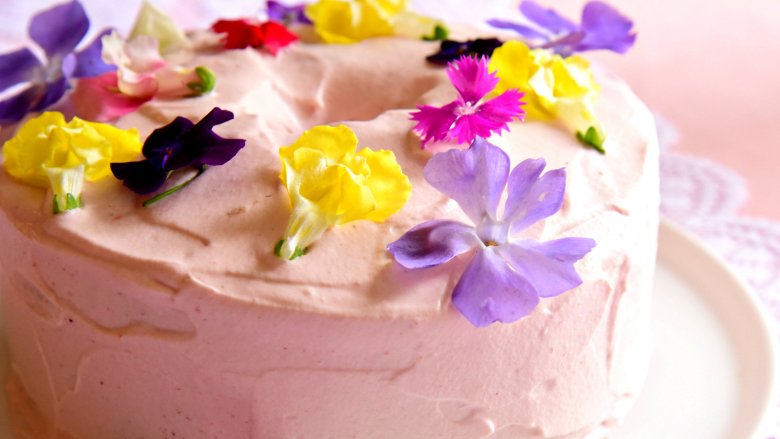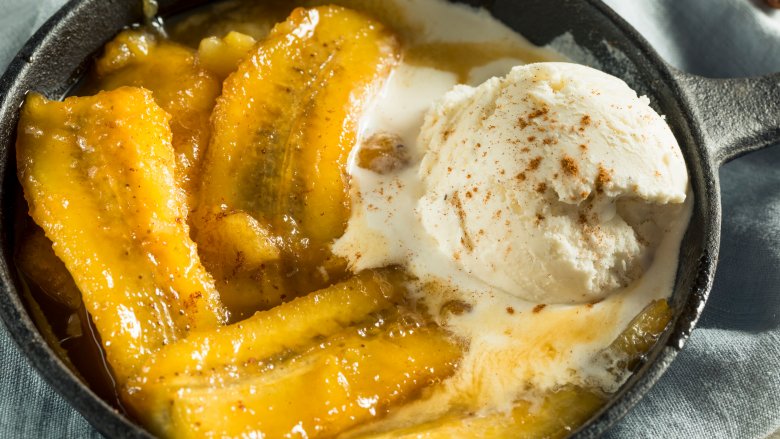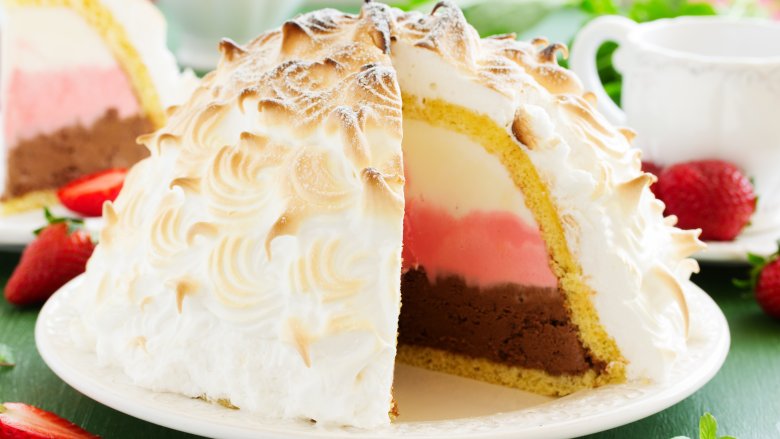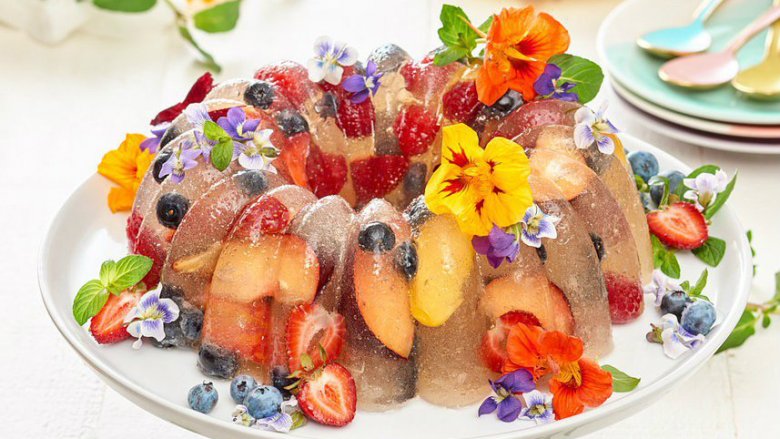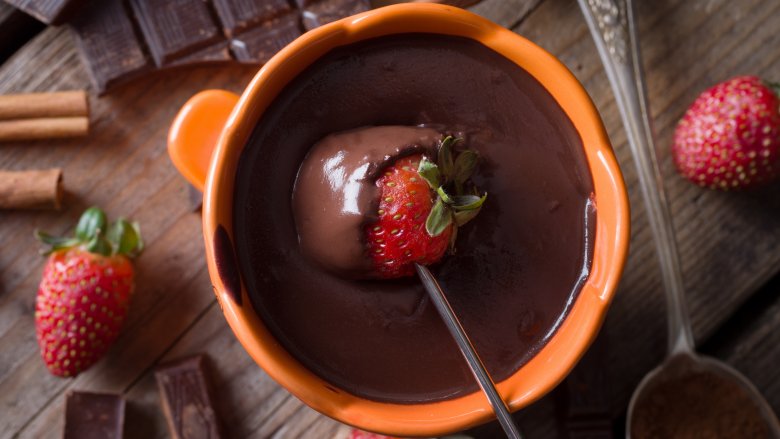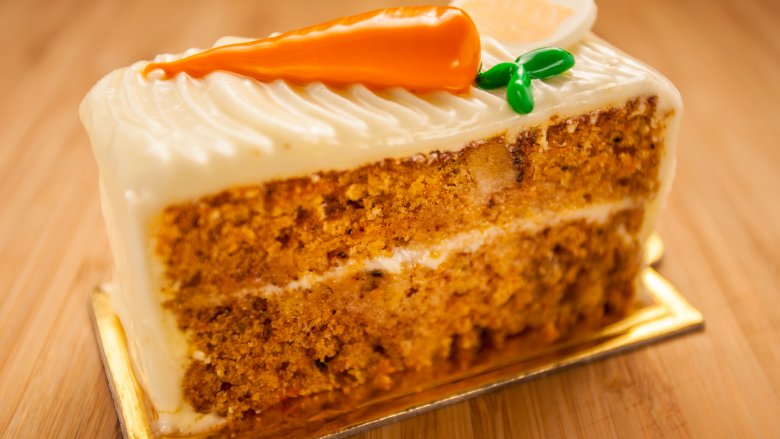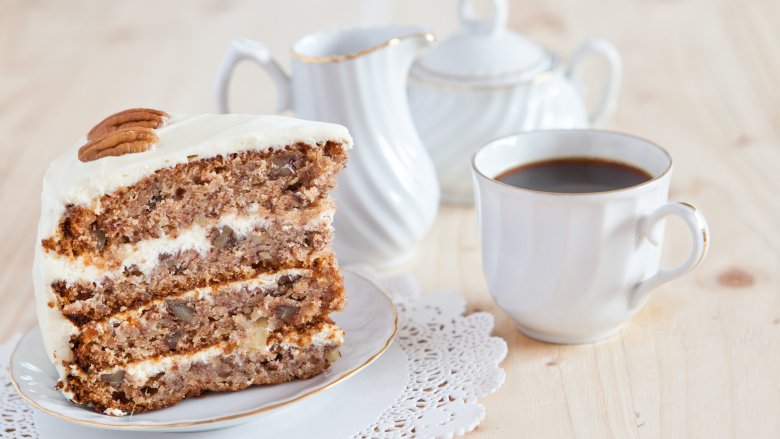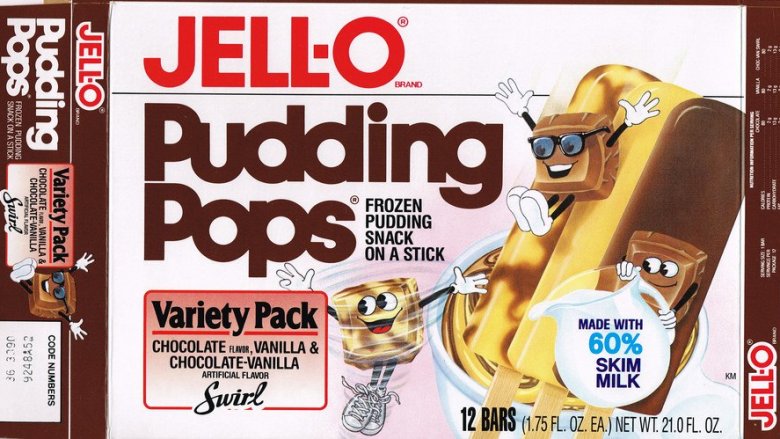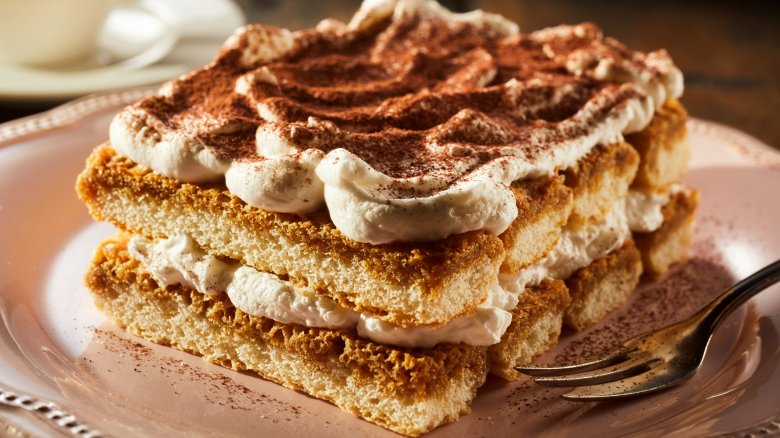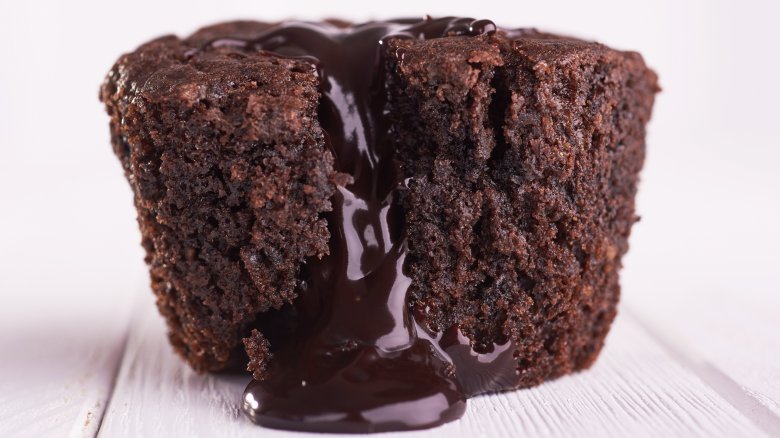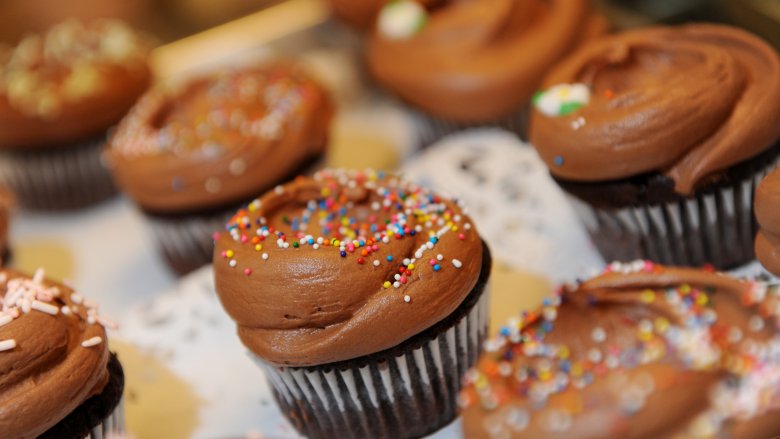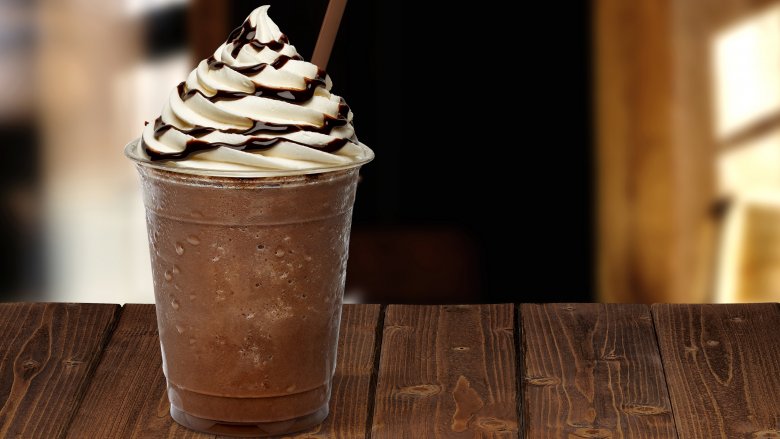The Most Popular Dessert The Year You Were Born
Dessert trends come and go, but a sweet tooth is forever. Whether you were born in the 1950s, during the era of elaborate chiffon cakes, pineapple upside down cakes, and Jello everything — or the 1990s, during the reign of molten lava cakes and gigantic frosted cupcakes, dessert trends have certainly changed throughout the 20th century and beyond. Some of these desserts you'd find on practically every restaurant menu at the peak of their popularity, and others could be found in the trendiest cookbooks and on the back of Betty Crocker mixes in your local grocery store.
We have rounded up almost 60 years of sugary classics, some of which endured the test of time and others that were merely a flash in the baking pan. Which dessert was the most popular the year you were born? Find out here, and then whip one up for a true taste of nostalgia.
1948-1952: Chiffon cake
Although the moist and airy chiffon cake was invented in 1923 by an insurance salesman named Harry Baker (no, really!) who wanted to make a less-dry variation on the angel food cake, this cake did not truly become a sweets icon until after he sold the recipe to General Mills in 1947, according to Food52.
In 1948, Better Homes and Gardens published an article about their "first new cake in 100 years," with an accompanying Betty Crocker recipe for orange chiffon cake. This cake called for vegetable oil in lieu of butter — which accounted for the added moisture, and was iced with a light "fluff" topping made with heavy cream and fruit. Chiffon cake took off quickly and became one of the premiere baking trends of the late '40s and early '50s. This sweet treat is reminiscent of smiling Leave it to Beaver-era housewives baking cakes from scratch all of the time.
1953-1957: Bananas Foster
Whoever thought soaking bananas and rum and lighting them on fire would persist as a novelty dessert trend throughout the mid-20th century?
The iconic Bananas Foster dessert was invented in 1951 by chef Paul Blange at Brennan's Restaurant in New Orleans. At the time, New Orleans was a major port of entry for banana imports into the United States and it was not uncommon for restaurants to receive giant shipments of bananas, according to New Orleans Online.
Chef Paul Blange was challenged to make a dessert from bananas since they had such an abundance of the fruit. The flaming recipe (served à la mode) that he created was published in Holiday Magazine and became a dessert fixture of Southern Creole cuisine. But that's not the story of this dessert's creation. As another story goes, Brennan's Restaurant owner Owen Brennan told his sister Ella —who was managing the restaurant at the time — to come up with a new dessert to honor the city's crime commissioner Richard Foster, and she decided to flambe bananas.
Though it's time as a reigning dessert across the country was short, it's still a staple in New Orleans.
1958-1962: Baked Alaska
Some of the most popular desserts of the mid-20th century were whimsical gimmicks. When it was was wildly popularized in the 1950s, Baked Alaska was considered a "surprise cake" with stiff peaks of torched whipped meringue on the outside and contrasting, cold ice cream cake on the inside.
The history of the Baked Alaska actually goes back to 1867, when it was invented in honor of the land acquisition deal of the Alaskan territory (hence the name of the icy dessert). But the dessert did not really take off until the 1950s when it received a burst in popularity after Alaska officially became the 49th state of America, according to The Secret Lives of Baked Goods.
To make the original Baked Alaska, you'll need a brownie base for the domed cake part of the dessert, 10 cups of softened ice cream, and a whipped meringue coating made from egg whites for the the outside of the cake. That doesn't sound simple — which may explain why it fell out of fashion.
1963-1967: Sparkling Jell-O mold
We can't talk about 1960s desserts without mentioning the king of all mid-20th century ingredients: Jell-O! The Mad Men era was brimming with all sorts of jiggly Jell-O recipes, from Waldorf salad to horrific, fish-shaped tuna-gelatin concoctions. Gelatin molds were an economical part of post-war domestic life, and were featured in practically every cookbook on the market.
But they weren't just for special occasions. The nuclear family's dinner table was not complete without a sweet dessert that featured Jell-O as its star ingredient. The sparkling Jell-O mold made with Champagne and fresh fruit (usually raspberries) was a dinner party favorite that made many 1960s shindigs feel fancier, according to Serious Eats.
Even though nowadays people are more likely to raise an eyebrow than emphatically dig into a Jell-O mold, modern spins on this classic recipe are still being made, especially in the Midwest. Everything old eventually becomes new again, right?
1968-1972: Chocolate fondue
Switzerland's national dish may have been around for centuries as a melted cheese dip, but the creation of the chocolate version of fondue is actually pretty recent. Chocolate fondue was invented in New York City in the mid-1960s by the long-closed Suisse Restaurant's Konrad Egli as part of a marketing effort by Toblerone, according to The Spruce Eats.
The original simple recipe called for Toblerone chocolate bars, heavy cream and Swiss firewater (kirschwasser).
After the dish was introduced to Suisse Restaurant's customers, chocolate fondue became a popular party food. Chocolate fondue sets began popping up in department stores and chic couples would throw fondue parties to dip skewers of fruit into bubbling pots of chocolate with friends.
To make chocolate fondue, simply melt chocolate in a double boiler with heavy cream and your choice of liqueur over a low heat, stir, and then pour into a fondue pot.
1973-1977: Carrot cake
By the 1970s, dieting and health-conscious lifestyles were having a resurgence in America, so lighter dishes became the norm. Carrot cake was especially popular because it was made with vegetables so it had to be healthier, right?
This beloved spice cake may use carrots as a main ingredient but it's also slathered in cream cheese frosting, so it's not quite as healthy as the name suggests. Nevertheless, carrot cake took the 1970s by storm and packaged versions were seen in the frozen aisle of almost every major grocery store. In 2005, the Food Network listed carrot cake as one of the top five food trends of the 1970s.
Try a modern take on this classic cake recipe here from Food & Wine Magazine, made with pecans, cinnamon, buttermilk, cream cheese frosting, and a pound of carrots (although some versions are also made with pineapple and raisins to give it extra texture and sweetness).
1978-1982: Hummingbird cake
The Hummingbird Cake — a pretty confection that's particularly popular in the South — is thought to have been first invented in Jamaica in the 1960s, according to Jamie Oliver. The recipe was brought over to America in the 1970s and caught on like sugar-glazed wildfire after a recipe was published in Southern Living magazine in 1978. From there, it has popped up in numerous blue ribbon-winning county fair contests around America and continues to be a Southern staple.
Originally known as the "Doctor bird cake" (named after a Jamaican bird), the Hummingbird Cake is a three-layer spice cake that's layered with crushed pineapples and bananas, topped with a thin layer of pecan brittle, and glazed in cream cheese frosting. Its closest cousin is the carrot cake, although no vegetables make their way into this recipe.
Though there are now many variations of the cake, the original recipe still shines as the most beloved.
1983-1987: Jell-O Pudding Pops
The trendiest dessert of the 1980s by far wasn't an elaborate cake recipe, but was actually something you could buy from the freezer section of pretty much any grocery store: Jell-O Pudding Pops. The iconic "Jell-O pudding frozen on a stick" commercials (starring the once-beloved Bill Cosby) made these refreshing chocolaty snacks a staple in most households (even more so than Fudgesicles!). They came in chocolate, vanilla, banana, and a chocolate-vanilla swirl flavor, and everyone had their favorite.
Even though the widespread popularity of Pudding Pops continued well into the 1990s, they were eventually discontinued when they failed to turn a profit. The Jell-O name was licensed to Popsicle in 2004 and they revived the pops, which apparently looked and tasted more like Fudgesicles than the original frozen dessert, according to Culinary Lore. Fans didn't like the new shape or texture, and they were eventually discontinued, too. If you've really got a hankering, though, you can still try one of the off-brands that make varieties of the pudding ice pop.
1988-1992: Tiramisu
Whoever thought lady finger sponge biscuits soaked in espresso, layered with mascarpone, and topped with cocoa powder would become one of the biggest dessert trends of the '80s and '90s? Although Tiramisu — which literally means "pick-me-up" — has its origins in Italy, it became a major staple at Italian-American red sauce restaurants in the 1980s, according to Eater.
Chef Lidia Bastianich said that shortly after she opened her restaurant, Felidia, in New York City in the early 1980s, tiramisu began spreading in popularity. By the late 1980s, the dessert was a mainstay at almost every Italian restaurant in the city.
In a 1985 New York Times article, prominent New York City chefs were already debating which of the dozens of variations of the dessert were authentic: Did you have to use espresso? Can you substitute cocoa powder for chocolate? Can the meringue be made without raw egg? Many different restaurants had their own versions, and they were all quite popular during this time period.
1993-1997: Molten chocolate lava cake
Molten chocolate lava cake — a dense chocolate cake filled with hot, liquid chocolate — was a dessert trend that could be found on almost every chic, urban restaurant menu throughout the 1990s.
Chef Jean-Georges Vongerichten allegedly invented this ooey-gooey dessert in 1987 by accident for his restaurant, according to Thrillist, after he undercooked a batch of chocolate cupcakes and their insides were melted. Originally known as the Chocolate Valrhona cake, the molten lava cake really took off in popularity when Vongerichten put it on the menu at his restaurant, JoJo, in 1991, and chocoholics couldn't get enough.
"I knew when I put it on the menu, it was going to be an instant hit," pastry chef Sherry Yard told Thrillist. "It was always neck and neck with the creme brulee as the most popular dessert. We didn't have Instagram then, but it was the viral dessert of the '90s."
1998-2002: Cupcakes
Before the late 1990s and the rise in popularity of Sex and the City, cupcakes were mainly a children's birthday party treat. But when Carrie Bradshaw and her gang were seen frequenting New York's Magnolia Bakery in the popular television show, novelty cupcakes began to boom in popularity, and long lines formed outside the once-quaint neighborhood bakery. These cupcakes were not your mom's Betty Crocker dainty recipes: They were softball-sized cakes in all manner of flavors, colors, and toppings.
From the late 1990s to the mid 2000s, people couldn't get enough of the cupcake craze and pink-themed bakeries entirely devoted to the miniature treats sprang up: Sprinkles, Crumbs, Baked by Melissa, and Georgetown Bake Shop.
In the late '00s, the cupcake frenzy seemed to die down, right around the time of the recession, only to be replaced with the doughnut and cronut trend. But cupcakes are still a novelty bakery treat that people of all ages love today.
2003-2007: Frappuccinos
At this point, we should probably admit that the ever-popular Starbucks Frappuccino is really more like a coffee-flavored milkshake than a caffeinated beverage. Even though the Frappuccino was born in the hot summer of 1995 and enjoyed growing popularity throughout the '90s and '00s, it was still considered a coffee beverage (even though it was frozen), until the first non-coffee versions — known as "Frappuccino Blended Crème" — were introduced in 2002.
New non-caffeinated flavors like Chocolaty Chip and Vanilla Bean really solidified Starbucks Frappuccinos as dessert milkshakes rather than frozen drinks masquerading as coffee. Also starting in 2002, Starbucks began offering a brand-new Frappuccino flavor every spring (or several), that were supposedly coordinated with the clothes seen on fashion runways that year, according to Boston Magazine.
This eventually gave way to ever-crazier concoctions like the colorful Unicorn Frappuccinos released recently, and annual events like "Frappuccino Happy Hour" that Starbucks fans look forward to every year.

